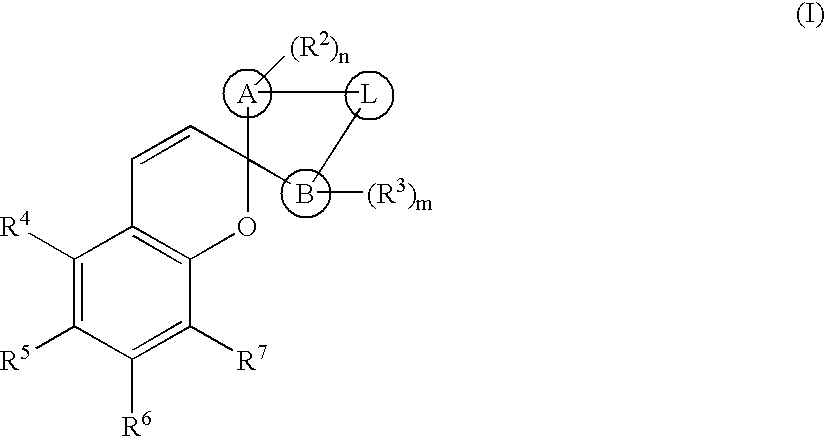Photochromic spiropyrans, and compositions and articles containing same
a technology of spiropyrans and compositions, applied in the field of photochromic spiropyrans, compositions and articles containing same, can solve the problems of incompatible with common ophthalmic applications, and insufficient colorability of naphthopyrans
- Summary
- Abstract
- Description
- Claims
- Application Information
AI Technical Summary
Problems solved by technology
Method used
Image
Examples
example 1
Synthesis of the Compound A
LiCCH.NH.sub.2 C.sub.2 H.sub.2 NH.sub.2 (9 g) are added in small portions, over a period of 3 hours, to a solution of 10,10-dimethylanthrone (7.5 g) in 40 ml of tetrahydrofuran, stirred at -10.degree. C.
The mixture is then stirred at 0.degree. C. for 2 hours. It is subsequently poured onto crushed ice. The propargyl alcohol obtained is extracted with toluene (3.times.400 ml). This gives a light brown solid after evaporation of the organic phase. The structure of the compound is confirmed by NMR spectroscopy. Yield: 8.3 g.
The product of the previous step (5.2 g) and 2-naphthol (3.32 g) are solubilized in 50 ml of tetrahydrofuran. A catalytic amount of p-toluenesulfonic acid is added and the mixture is kept at room temperature and under a nitrogen atmosphere for 16 h. The solution is then poured into 100 ml of water and 100 ml of diisopropyl ether. The organic phase is recovered, washed three times in 30 ml of aqueous sodium hydroxide solution (1 N) and then...
example 2
Synthesis of the Compound B
7 g of the propargyl alcohol of Example 1, 8.8 g of 2,6-dihydroxynaphthalene and a catalytic amount of paratoluenesulfonic acid are solubilized in 125 ml of tetrahydrofuran in a 100 ml reactor and the mixture is kept at room temperature for 2 hours. It is subsequently poured into 100 ml of water, after which 100 ml of methylene chloride are added. The organic phase is recovered and then reduced to dryness. Chromatography on a silica column with a tolueneldichloromethane eluent gives the "hydroxylated" intermediate with a yield of 25%. This is then methylated with dimethyl sulfate in acetone, in the presence of potassium carbonate. The desired product (B) is obtained, after purification, in the form of a yellowish powder with a yield of 75%. Its structure is confirmed by NMR spectroscopy.
example 3
Synthesis of the Compound C
10 g of anthrone, 5 g of LiOMe and 16 g of diiodobutane are mixed with 100 ml of xylene in a 250 ml reactor and the reaction mixture is refluxed for 16 h. It is then poured into 100 ml of water and 200 ml of toluene. The organic phase is extracted, washed with aqueous KOH solution and then reduced to dryness. The solid obtained is macerated in 100 ml of heptane and then filtered off and dried to give 9 g of spirocyclopentylanthrone. The propargyl alcohol of the latter is obtained, as in Example 1, by reaction with lithium acetylide in tetrahydrofuran at -10.degree. C.
The compound (C) is then obtained, in a manner analogous to that described in Example 1, from the propargyl alcohol of spirocyclopentylanthrone and 2-naphthol. The product (C) is isolated in the form of a cream-colored powder with a yield of 18% and its structure is confirmed by NMR spectroscopy.
PUM
| Property | Measurement | Unit |
|---|---|---|
| temperature | aaaaa | aaaaa |
| temperature | aaaaa | aaaaa |
| temperatures | aaaaa | aaaaa |
Abstract
Description
Claims
Application Information
 Login to View More
Login to View More - R&D
- Intellectual Property
- Life Sciences
- Materials
- Tech Scout
- Unparalleled Data Quality
- Higher Quality Content
- 60% Fewer Hallucinations
Browse by: Latest US Patents, China's latest patents, Technical Efficacy Thesaurus, Application Domain, Technology Topic, Popular Technical Reports.
© 2025 PatSnap. All rights reserved.Legal|Privacy policy|Modern Slavery Act Transparency Statement|Sitemap|About US| Contact US: help@patsnap.com



